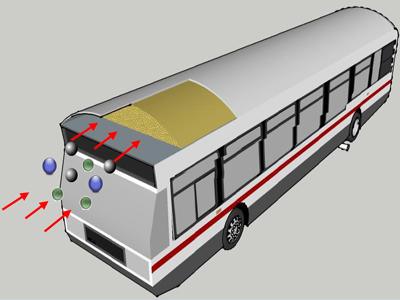May 12, 2014
Student team designs a clean air solution inspired by nature

An illustration of how particulate matter could be removed to reduce air pollution using transit.
Velcro® may be the most widely recognized product to have been invented using a natural model, with hooks designed to mimic those found on burrs. Now a group of University of Calgary students is competing in a challenge that turns to nature for inspiration in finding innovative and sustainable solutions.
For the past few years, the Biomimicry 3.8 Institute has hosted a Student Design Challenge (SDC) aimed at college and university students that invites student teams to work collaboratively in applying biomimicry concepts and tools to arrive at sustainable and innovative design solutions.
The concentration this year is Life-Friendly Transportation Solutions, where students must design a project that will focus on making transportation more user-friendly or on the reduction of the environmental impact from transportation.
A team from the University of Calgary has registered and submitted a design into this year’s challenge. The team consists of students Lucas Martins, Thibault Bram and team leader Jason Hawkins. Their project focuses on removing particulate matter from the air to reduce air pollution using the transit system.
After many biological model considerations, the team decided to design their filters on sea sponges, which filter water through mucus filled pores to capture food. The design is meant to contain foam filters of decreasing pore size, which would be placed on top of public buses. When the bus is in motion, the unfiltered air would flow into the larger pore filter at the front, through to the small pore foam and finally out the back of the bus as clean filtered air.
“I was a little nervous about the project because I hadn't taken biology since the tenth grade but I really enjoyed learning how natural processes developed over millions of years can be used to improve engineering designs,” said Jason Hawkins on his experience with the SDC.
Winners of the challenge will be announced on May 20, with first place being awarded a $2,500 prize, and second and third receiving $1,000 and $500 prizes respectively. Over 150 teams are competing from around the world.
Spotlight on Sustainability is an ongoing series profiling the work of students, faculty and staff. To submit story ideas please contact the Office of Sustainability.
